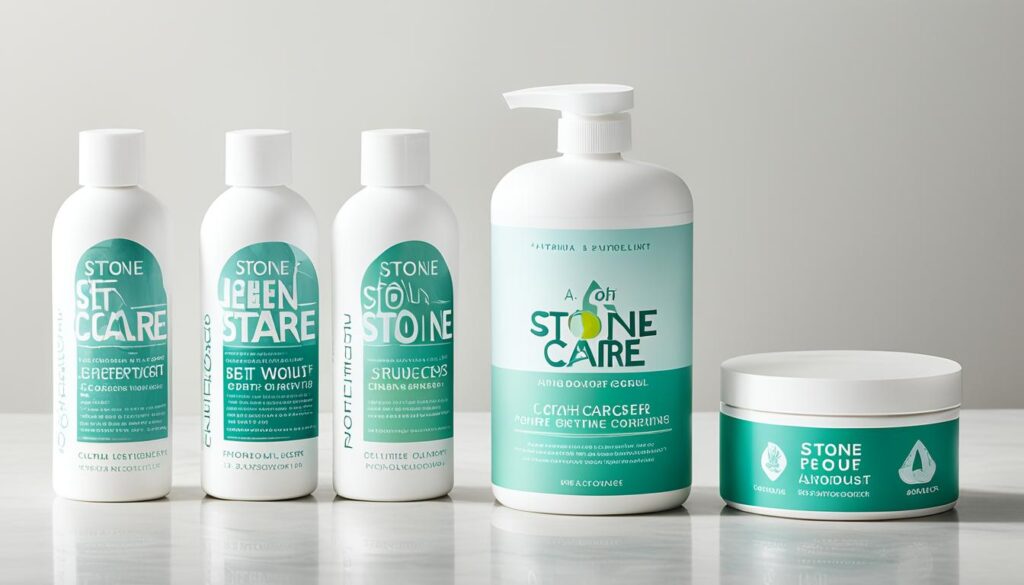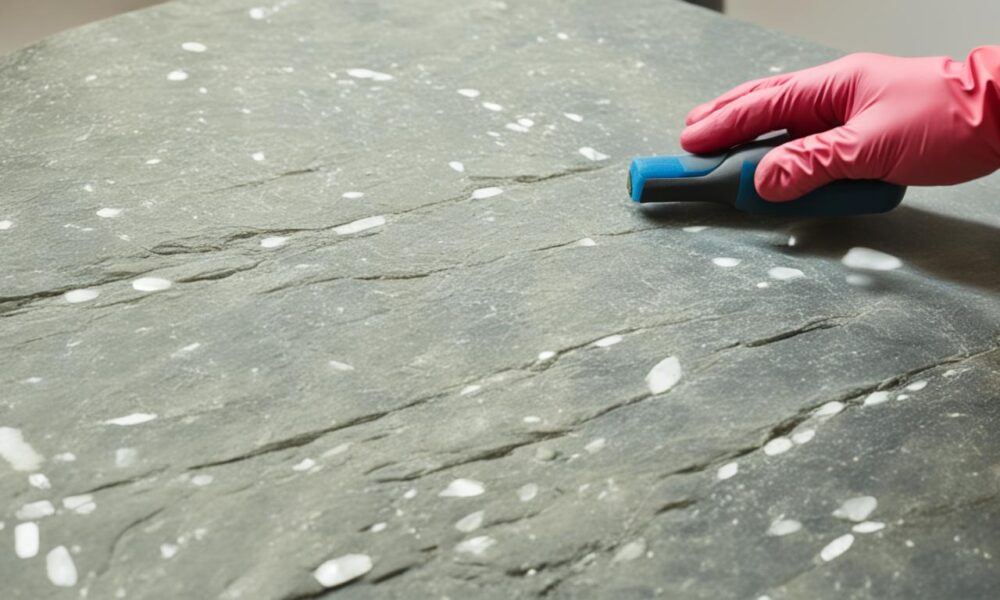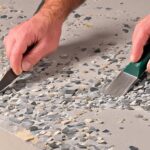Revitalize Your Floors: Restore Natural Stone Shine
Natural stone floors like marble and granite mix durability with timeless charm1. With proper care, these materials can last forever, making them a smart choice for any setting1. Yet, these stone floors are porous and can show wear, damage, and stains without specialized upkeep1. Some think these floors resist stains on their own, but many can actually soak up liquids and get stained1.
To keep your floors looking great and strong, you need to clean deeply and seal them regularly1. Sealing cuts down on stains and scratches, while also making the stone last longer1. Experts in this field can really help bring back and keep up the surface’s beauty, using the right techniques to avoid harm1. Corporate Care stresses fixing over replacing to lessen waste and prolong floor life in commercial spaces1.
Key Takeaways
- Natural stone floors can last indefinitely with proper care1.
- These surfaces are prone to wear, damage, and stains, requiring specialized maintenance1.
- Sealing stone floors helps minimize stains and enhance longevity1.
- Professional restoration is crucial for maintaining the beauty and functionality of stone floors1.
- Corporate Care offers tailored maintenance programs to ensure lasting results1.
Why Natural Stone Floors Need Special Care
Natural stone flooring needs unique care. This is because of its special characteristics. Knowing and using the right care methods can keep your floors beautiful and lasting longer.
The Unique Properties of Natural Stone
Natural stone, like marble, granite, and limestone, is quite porous. This means it can easily stain from substances such as lemon juice or vinegar2. Special care is needed to keep these floors looking great. Stone tiles and countertops can vary, so buying extra is smart to match everything perfectly2. Also, some stones like marble and onyx are almost see-through. This makes them look beautiful but they need to be handled gently2.
Challenges in Maintaining Natural Stone Floors
To take care of natural stone flooring, it’s important to meet its unique needs. Regularly vacuuming and dust-mopping helps protect the surface3. It’s vital to use special cleaning products to avoid damage. Brands like Bona and Dupont Stonetech are good choices for these floors3. Placing rugs or mats at entrances can also keep floors safe from dirt3.
The Importance of Regular Sealing
Sealing your stone floors is key to keeping them in top shape. It’s especially recommended when the stone is first installed2. Sealing every few years helps protect and maintain the floor’s look2. Penetrating sealers are great for keeping a natural appearance and last a long time2. For older or outdoor stones, enhancer sealers can improve their color and beauty2.
Proper care is crucial for natural stone floors. Companies like Corporate Care can help meet each stone’s specific needs. Their experts offer services like honing, polishing, and grout cleaning. These are key for keeping your stone floors beautiful. It’s recommended to clean them professionally every 12 months, depending on use3.
How to Restore the Shine of Your Natural Stone Floors
Getting the shine back on natural stone floors requires careful steps. It’s about making them look great and last long. It’s important to know what your stone needs and pick the right way to fix it for a beautiful, long-lasting finish.
Assessment and Preparation
Start by figuring out the stone’s type and condition. Stones fall into three groups: metamorphic, sedimentary, and igneous4. Knowing if your stone is calcareous or siliceous helps choose safe cleaning methods. Calcareous stones can’t handle acidic cleaners, unlike siliceous stones4. An acid test will show which kind you have4.
Deep Cleaning Techniques
Cleaning deep into the stone gets rid of tough dirt and stains. Use stone care solutions mixed at a 1:5 ratio4. Proper cleaning involves five steps: prep, apply cleaner, scrub, rinse, and dry4. Then, let the sealant sink in for 15 minutes for the best results4.
Polishing and Sealing
Polishing your stone floors can remove small marks and add shine. Mechanical polish targets minor scratches for a glossy look5. Topical polish usually stops at a 200- or 400-grit level5. After polishing, apply a sealer to protect and brighten the stone. This sealant needs three days to fully set, ensuring your floors stay beautiful and strong4.
Here is a table summarizing key steps in restoring stone floors:
| Step | Description |
|---|---|
| 1. Assessment | Identify stone type and condition; test for acid sensitivity4 |
| 2. Preparation | Choose the appropriate non-acidic cleaning solutions for calcareous stones4 |
| 3. Deep Cleaning | Follow a five-step cleaning process, allowing sealant to sit for 15 minutes4 |
| 4. Polishing | Use mechanical polishing to remove small scratches and enhance reflectiveness5 |
| 5. Sealing | Apply sealant and let it cure for three days for maximum effectiveness4 |
Common Mistakes to Avoid in Natural Stone Floor Restoration
Maintaining the beauty of natural stone floors can be hard. Avoiding common mistakes is key to ensure they look their best. Proper care is essential to extend their life.
Using Incorrect Cleaning Products
Choosing the wrong cleaning products is a major mistake. Acidic cleaners can harm stone floors, especially marble. They cause permanent damage6. It’s important to use cleaners that are alkaline or have a neutral pH6. Sometimes, facility managers pick wrong cleaners because they misidentify the stone6.

Ignoring Regular Maintenance
Neglecting regular floor care is another issue. Dust and wet mopping daily help keep the floor looking good6. Also, using a rotary machine for light buffing helps avoid buildup6. Not reapplying sealers regularly can lead to quicker deterioration of the stone7.
DIY vs Professional Restoration
DIY stone care might not match a professional’s work. Experts like Stoneshine have the right training and tools. They expertly fix scratches, stains, and other damage7. Using professionals prevents further damage, ensures safety, and keeps the warranty valid.
Best Practices for Stone Floor Care
To take good care of natural stone floors, clean them daily, pick the right cleaning products, and follow a set maintenance plan. By doing this, your floors will look great and last a long time.
Daily Maintenance Tips
Start by sweeping your stone floors often. This helps avoid scratches from dust and grit8. Place protective pads under furniture to prevent scratches too9. For marble floors in busy spots, sweeping every day is key8.
Entrance mats reduce dirt from outside, which protects the floor further9.
Choosing the Right Products
Look for cleaning products labeled “neutral,” “residue-free,” and “pH 7” when cleaning stone floors8. Avoid acidic cleaners since they dull stone surfaces9. Use products like Lithofin Wash & Clean that are made just for stone floors10. Also, soft mops and non-abrasive cloths are best to prevent scratches9.
Setting Up a Maintenance Schedule
It’s important to have a regular care schedule for your stone floors. You’ll need to seal the floors sometimes to keep them from staining and absorbing moisture9. In places like bathrooms, where there’s a lot of water, you might have to seal the floors more often than every 4-6 years10. Cleaning up spills right away helps avoid stains too9.

Conclusion
Making stone floors shine again takes careful steps, starting with a professional look. It’s about picking the right way to clean and keeping up with it. Floors like marble and granite get shiny with a process called diamond polishing11. This begins with rough grits of 100 to 200 and ends with very fine 1500 to 6000 grits for shine11. Using machines set at 175 RPM11 and a detailed checklist helps ensure everything goes smoothly.
Experts are often needed to bring stone floors back to their best. They know how to avoid common problems and make floors look great. DIY can work too, but it means carefully going through each step and fixing any issues like dull spots11. The right resources and pads, as listed in checklists, lead to a brilliant finish. For a comprehensive guide, you can visit how to restore your stone floor.
Everyday care is key to keeping stone floors looking good11. This includes things like using water wisely and watching how the pads wear down. Planning a care routine and choosing the best products help maintain the floor’s value. Getting advice from pros and waiting for floors to dry are also essential for a perfect shine11. With expert guidance and regular care, restoring the glow to stone floors is possible and sustainable, making spaces beautiful for a long time.
FAQ
How often should natural stone floors be sealed?
Can I use any cleaning product on natural stone floors?
What’s the best way to clean natural stone floors daily?
Is professional restoration necessary, or can I do it myself?
How can I protect my natural stone floors from scratches?
Are natural stone floors really that high maintenance?
What are the signs that my natural stone floors need professional restoration?
Can I restore the shine of my stone floors on my own?
How should I set up a maintenance schedule for my natural stone floors?
What are the common mistakes in natural stone floor restoration?
Source Links
- Revitalize Your Floors with Natural Stone Care | Corporate Care
- Natural Stone Tile Step-by-Step Care & Maintenance
- How do I Care for my Natural Stone Flooring? – Pro-Care
- 5 Tips for Restoring Your Stone Floor
- Restoring Natural Stone Floors
- Add Beauty to Your Facility With Natural Stone Floors | Cleaning & Maintenance Management
- How Do You Brighten & Restore Shine to Dull Natural Stone Surfaces in Green Valley Ranch, NV? – Las Vegas Floor Restoration
- How to Clean Stone Floors
- Shine On: Revive Your Natural Stone Floor with These Expert Tips
- How to Clean Natural Stone Tiles | Quorn Stone
- The Ultimate Diamond Polishing Guide for Stone Floors



